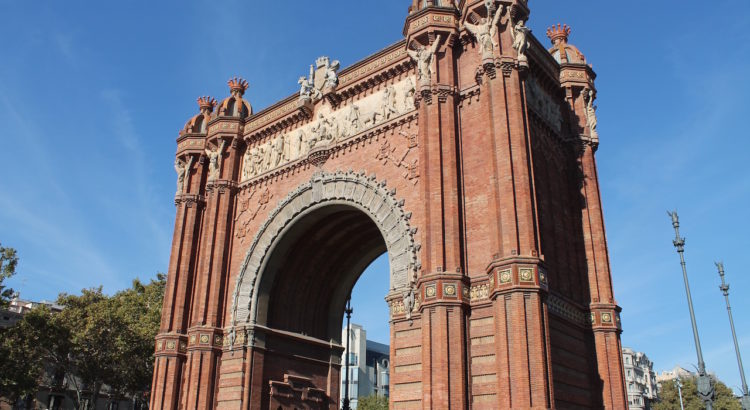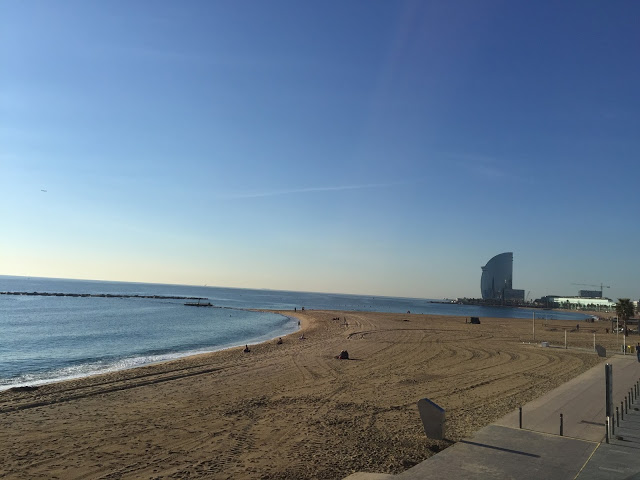We said goodbye to Seville the next morning and caught our train to Barcelona. We made it to Barcelona in the early afternoon and checked into our hotel. We selected the Evenia Rosselló Hotel located on Carrer del Rosselló in the commercial center of Barcelona, near the Paseo de Gracia and the Agenda Diagonal. The hotel has about 94 rooms ranging anywhere from roughly $80 – $170 depending on the size of room. The hotel offered a gym, parking, free wi-fi, and breakfast. The rooms were comfortable and clean. Only thing I would recommend is ask for a room facing the street – the back of the hotel juts up to a playground, which, when filled with screaming children, is really loud.
 |
| Front of hotel; ©www.tripadvisor.co.uk |
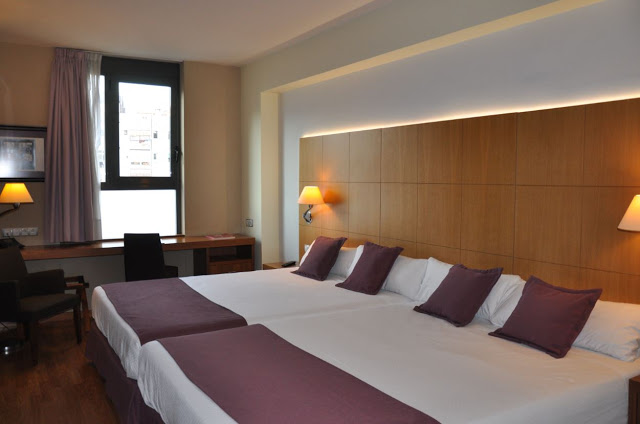 |
| Example of a room; ©www.rossello-barcelona.eveniahotels.com |
 |
| The back of the hotel and the park. |
After checking in, we grabbed some lunch at Basque Palermo located on Carrer de València. They’re known for their seafood paella and cured meats, usually served in large portions. After lunch we meandered over to the gothic district of Barcelona and walked around, checking out the shops and taking a quick peak at the Barcelona Cathedral.
One of my favorite things about Barcelona (and Madrid) were the numerous street performers that dotted the alleyways and side streets. Almost all of them were incredibly talented. My favorite was this amazing french horn player who expertly lined up his playing with pre-recorded classical music. It was so beautiful. Around the corner was a woman singing opera in the middle of a small square. She had a young man accompanying her on a guitar, but she carried the tune almost exclusively by herself. Her voice was incredible, and echoed perfectly off the walls. I could have listened to them both all night.
We had dinner that night at La Arcano, one of our favorite restaurants of the entire trip. Located on Mercaders 10 in La Ribera-Born, of the “old city” areas of Barcelona, La Arcano fit the gothic district to a t. The inside was made up of some of the old Barcelona walls with stone arches lining the dining area. The lighting was perfect, with small plants decorated around the restaurant, a gorgeous full bar, and elegant seating with plenty of privacy. The restaurant was lively and dignified.
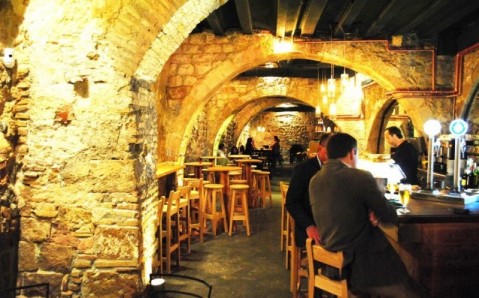 |
| ©www.barcelonatravelguide.org |
Andy of course got the Filet Argenti Angus (Argentine Angus Sirloin); dad and I both got the Raviolis D’espinacs I Ricotta (raviolis with spinach and ricotta). The food was excellent and the service was top-notch. We would highly recommend this restaurant.
 |
| Filet Argenti Angus |
 |
| Raviolis D’espinac I Ricotta |
The next day Dad decided to spend the morning relaxing at the hotel, so Andy and I strolled down La Rambla with plans to meet Dad for lunch at La Boqueria. La Rambla is a very popular tree-lined mall in Barcelona that runs about 3/4 of a mile from Plaça de Catalunya to the Christopher Columbus Monument at Port Vell. Spanish poet Federico García Lorca called it “the only street in the world which I wish would never end.”
You will often hear the street referred to as “Les Rambles” or “Las Ramblas”; this is because La Rambla can technically be viewed as a community of smaller streets that make up some of the major attractions on La Rambla, such as the open-air flower market on Rambla de Sant Josep and the Liceu opera house on Rambla dels Caputxins. La Rambla boasts some beautiful shops and stores, flower markets, food and jewelry vendors, and a variety of cultural establishments including the Teatre Principal, the oldest theater in Boston, the Centre d’Art Santa Mònica, a public museum of contemporary art, and the Palau de la Virreina, a Baroque Palace. One word of caution, however: over the years, La Rambla has become very popular for pickpockets. Keep your belongings secure!
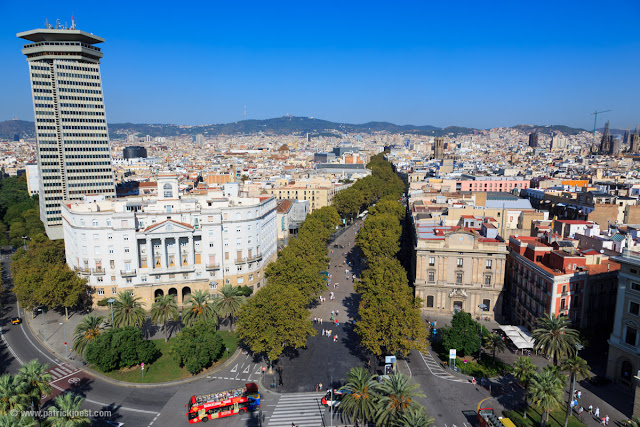 |
| La Rambla ©www.everythingbarcelona.net |
We stopped part way down La Rambla for a drink at Patagonia, which was a huge find. We stumbled into it at random; we had originally agreed to meet Dad for lunch at La Boqueria, an exciting and fast-paced food market about 2/3 of the way up La Rambla; after stopping there, however, we realized it’s not really a spot that’s conducive for lunch; it’s a bustling and busy market with no real places to sit and stop to eat (however, make sure you explore if it you have time, it’s an iconic part of La Rambla).
 |
| La Boqueria ©www.driftwoodjournals.com |
We looked directly across the street for a good second option and saw Patagonia. It didn’t look like much, but we ducked inside anyway. Come to find out, there was an upstairs private bar area with high-top tables next to little balconies that overlooked La Rambla. It was a perfect table; the waitress was friendly, the wine and food was delicious, and it was a perfect place for people watching. We mistakenly thought it would work just fine to find a restaurant near La Boqueria and sent Dad an email letting him know the change of plans. Apparently Dad didn’t have a international data plan on his iPad, so there he stood, in front of La Boqueria, wondering if we had abandoned him or possibly died. He finally figured it out. He was a tad…miffed…but Patagonia won him over.
 |
| Bar in the upstairs area of Patagonia |
 |
| Table by the window |
 |
| Donkeys, people watchin’ |
 |
| Donkey. Thuggin’. |
 |
| View from our table; look at all the people up and down La Rambla! |
After a small bite to eat and a drink at Patagonia, we continued on down La Rambla to La Barceloneta, a neighborhood in the Ciutat Vella district, known primarily for the sandy beach that juts up against the Mediterranean Sea. We didn’t have time to explore the neighborhood beyond the beach, but if you do get a chance be sure to check out the intricate side streets and alleyways, as well as the Casa de la Barcelona museum, Rebecca’s Horn’s “Homentage a la Barcelona” monument, and Frank Gehry’s modern “Piex d’Or” sculpture.
The best part, in our opinion, is the beach. It’s gorgeous and pristine. We advise, however, to visit the beach and this area during the day; pickpockets are popular in this area at night.
 |
| Find the donkeys and Arrojado! |
We made our way back up towards the hotel and stopped to admire the Arc de Triomf, Spain’s version of Arc de Triomphe. Built as a main access gate for the 1888 Barcelona World Fair by the architect Josep Vilaseca i Casanovas, the arc sits over Passeig de Lluís Companys which leads you into a large square/promenade that ends at Ciutadella Park.
After exploring the Arc de Triomf, we headed back to the hotel to freshen up and rest. We were headed to the OPERA!
I love the Opera, but living in Fairbanks, Alaska, there’s not a lot of opportunities for true opera. Fairbanks has the Fairbanks Light Opera Theater, which is a beloved community event, and an excellent one at that, but it’s just not the same experience as opera in a big, cosmopolitan city. The opera playing in Barcelona was Nabucco, an Italian-language opera consisting of four main acts that mirror the Book of Jeremiah and the Book of Daniel: Jerusalem, The Impious One, The Prophecy, and The Broken Idol. Lyric Opera describes Nabucco as “on one side, the fiery Hebrew priest Zaccaria, battling to lead his people from oppression. On the other, Nabucco, the tyrannical Babylonian king and his adopted daughter Abigaille, who will stop at nothing to get her father’s throne and her sister’s lover.” Read more here.
Nabucco was playing at the Gran Teatre del Liceu, founded in 1847 established by a group of Spanish entrepreneurs with a love of opera. It’s one of the most iconic and beloved Barcelona establishments, and hosts the leading artists, orchestras, and ballets of the world. It has a connection to the American world as well; the Liceu Barcelona Opera House US Foundation was established to encourage patronage by American tourists. The opera house was beautiful!
The opera went late – almost to midnight! It was a fantastic show, one of the most memorable and classiest events we’ve seen on our travels. If you have any sort of love for the arts, it’s a must see. Tomorrow we were off to see La Sagrada Familia!
